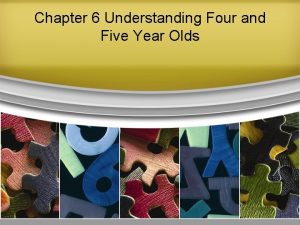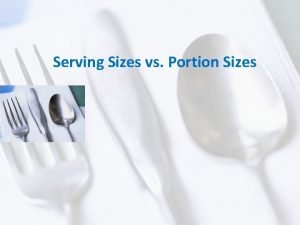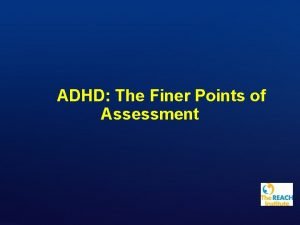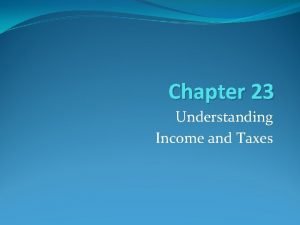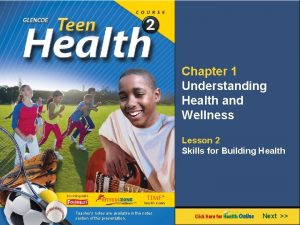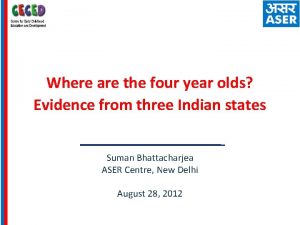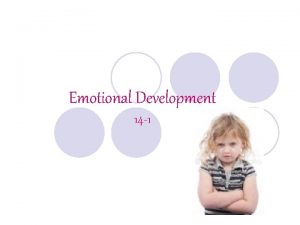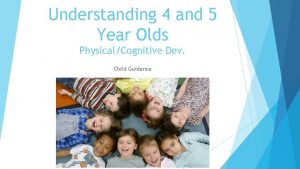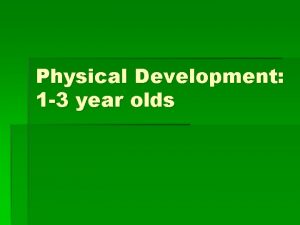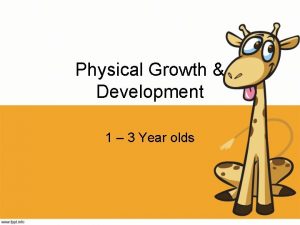Understanding four and FiveYear Olds Chapter 7 Physical













- Slides: 13

Understanding four and Five-Year. Olds. Chapter 7

Physical Development in Four and Five year Olds • Physical skills become easier partly because body proportions are changing. • Compared to their total height, toddlers have fairly short legs. • By the age of five, in most children, legs constitute for about half of the height of the child. • Their bones are becoming harder and stronger. • Their permanent teeth are forming beneath their gums.

Gross Motor Development • Late in the fourth year, many children may begin learning how to skip. • Older four-year-olds many also be riding a bike without training wheels. • Five year olds can also walk forwards and backwards on a balance beam. • They can jump from table height and land on both feet. • Throwing and catching skills also improve during these years.

Fine Motor Development • They find it easier to string beads and work with small game or puzzles. •

Self Help Skills: • Preschoolers can dress and undress themselves. • Most can tell the difference between the front abd the back of clothing. • By 4 most children can buckle belts and close zippers. Between four and five children can distinguish between the left and right shoe and tie shoes.

Cognitive Development of Preschoolers. • They make great gains in understanding the world around them. • Four and five year old have language skills to describe what they see and remember. • Children have better recognition than recall skills.

• WHAT KIND OF MEMORY DO YOU HAVE ?

Language Comprehension Skills • New words related to space increase their understanding. These include words such at: beside, above below, behind, and around. • Children have a better understanding between the singular and the plural. • Children start to understand the passive voice.

Language Skills READING; Expressive Skills: • This ability increases as children learn to understand symbols. • They can recognize their own names • Articulation: is the ability to speak in clearly pronounced sounds. Articulation tends to improve at ages four and five. • Some preschoolers suffer from stuttering. Stuttering includes repeating sounds or words and pausing for unusually long times while speaking.

Language Skills Vocabulary: Grammar: • Most four and five year olds have about 1, 500 words in their vocabularies. Five-year -olds have about 2, 000. • They use some irregular verbs as ate, ran, and went properly. These children still put –ed at the end of words occasionally.

SOCIAL DVELOPMENT: EMOTIONAL DEVELOPMET; Companionship • Companionship is important to preschoolers. Friendships , attention and appreciation is important as well. • Children are becoming more independent of adults. They like to play on their own or without other kids. • Chilren this age start to value friendship and have very few friends. They also prefer friends of the same sex. • Over one third of children in this age group play alone. • Four and five year olds begin to realize new ways of showing love and caring. • Children I this age group start to develop a sense of humor. Laughter becomes a way of expressing their happiness. • FEAR; • Fears are sill common, but most only last a few months. Causes of fears change during this state. These children are still afraid of imagined creatures, such as monsters and ghost.

Social Development ANGER/ JEALOUSY; SADNESS • These children have less reasons to be angry. They become angry is they cannot achieve their goals. • These children are most likely to become jealous of a new sibling; brother or sister. • Four and five year olds start to learn that some situations are sad. They become aware of they concept of death.

TEACHING FOUR AND FIVE YEAR OLDS. • Because these children like to help, you need to carefully select helpers. Choosing the same few helpers time after time can make others feel unimportant.
 Understanding four and five year olds
Understanding four and five year olds What does 2 ounces of meat look like
What does 2 ounces of meat look like Adhd in 4 year olds
Adhd in 4 year olds The possessive sharon olds
The possessive sharon olds Peter olds
Peter olds Two sided shape
Two sided shape Chapter 23 understanding income and taxes
Chapter 23 understanding income and taxes Understanding your health and wellness chapter 1
Understanding your health and wellness chapter 1 Chapter 1 understanding health and wellness answer key
Chapter 1 understanding health and wellness answer key Understanding your health and wellness chapter 1
Understanding your health and wellness chapter 1 Lesson 4 promoting health and wellness
Lesson 4 promoting health and wellness Chapter 1 understanding health and wellness lesson 2
Chapter 1 understanding health and wellness lesson 2 Chapter 1 lesson 2 what affects your health
Chapter 1 lesson 2 what affects your health Understanding health and wellness
Understanding health and wellness
